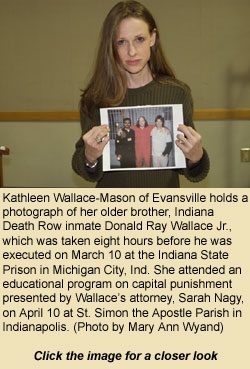Executions raise questions about inmates
with mental illness, addictions
By Mary Ann Wyand
 Indiana Death Row inmate Bill J. Benefiel, who was convicted of rape and murder in 1987 and diagnosed with latent schizophrenia, was scheduled to be executed by chemical injection on April 21 at the Indiana State Prison in Michigan City, Ind.
Indiana Death Row inmate Bill J. Benefiel, who was convicted of rape and murder in 1987 and diagnosed with latent schizophrenia, was scheduled to be executed by chemical injection on April 21 at the Indiana State Prison in Michigan City, Ind.
Benefiel’s attorneys and opponents of the death penalty asked Gov. Mitch Daniels to commute his capital sentence to life in prison without parole because of his mental illness, a schizotypal personality disorder characterized by suspicion, hallucinations and inability to perceive reality.
Benefiel was convicted of kidnapping, confining and raping two women, and killing one of the rape victims, a Terre Haute resident, in 1987.
His birth mother sold him for adoption to a woman who operated a brothel, and he was sexually abused during his childhood.
St. Susanna parishioner Karen Burkhart of Plainfield, the Indiana death penalty abolition coordinator for Amnesty International, said on April 10 that state laws prohibit the execution of mentally retarded and juvenile offenders, and hopes legal protection will be extended to offenders suffering from mental illness and addictions.
“Maybe the next thing we’ll do is eliminate the execution of people with mental illness,” Burkhart said, “another step forward in the continuing movement toward eventual abolition of the death penalty.”
She cited medical studies that link alcoholism and drug abuse to mental illness.
“A lot of people addicted to drugs and alcohol may have had a mental illness,” she said. “There’s a reason why people medicate themselves.”
On March 10, the state executed Donald Ray Wallace Jr. of Evansville, Ind., for the January 1980 murders of St. Theresa parishioners Patrick and Theresa Gilligan of Evansville and their children, 5-year-old Lisa and 4-year-old Gregory, after they interrupted a burglary in their home.
Wallace said he used drugs at the time of the murders.
Kathleen Wallace-Mason of Evansville was 10 years old at the time of the murders, 12 years younger than her brother.
In an April 10 interview at St. Simon the Apostle Parish in Indianapolis, on the one-month anniversary of her brother’s execution, Wallace-Mason said, “When I was little, I never had any idea that he was using drugs. … He always pulled himself together around me when he would come to visit us when I was little and whenever I saw him in prison. I never saw that other side of him. … He was always so sweet. He was a good big brother.”
Wallace-Mason said she misses her brother “so much” and believes he had changed for the better in prison.
“I felt like he found peace in God,” she said. “That’s helped me through the belief that I will see him again. … It’s still hard to know that he was involved in something like that. It was very hard to reconcile that because the man that I knew would not have done that.”
She said watching her brother be executed by lethal injection at the Michigan City prison was “the most horrific thing I’ve ever experienced.”
It was hard growing up in Evansville, she said, where people knew the family.
“Do not ignore the family of the offender because they’re hurting too,” Wallace-Mason said. “No one wanted to really reach out to us over the years. But at the end, some people did.”
Attorney Sarah Nagy, a St. Simon the Apostle parishioner from Indianapolis, represented Wallace in the appeals phase of his capital sentence.
Nagy presented an educational program about the death penalty on April 10 at St. Simon Parish.
“Donald Wallace was very, very bright,” Nagy said. “He had a genius IQ.”
She showed the gathering a photograph of Wallace standing with his arms around his two spiritual advisers that was taken eight hours before his execution.
“He was very happy, as you can see from the picture, and very much at peace before his execution,” Nagy said. “I think that executions are more difficult on the family members of the person executed, the victims of the crimes, and the witnesses—the community—which participates in the execution. In many ways, those are new victims to the original crime which was committed.”
Nagy discussed two questions—“Does society have the right to put a criminal to death for committing a heinous offense?” and “If society does have that right, do the circumstances of the modern world warrant society’s exercise of that right?”
Those questions are dominant themes found in the Catholic Church’s history, she said. Citing Old and New Testament references, the Catechism of the Catholic Church and other sources, she examined Church teachings on capital punishment.
“There are arguments … in the Old Testament against imposing the death penalty,” she said. “The first murderer in the Old Testament was not punished by death. … When Cain killed Abel, God protected Cain from elimination for his offense. He put a mark on him so that no one would harm Cain (Gn 4:15).”
In the New Testament, Nagy said, “… Jesus called upon his disciples to be merciful … and discouraged a spirit of vengeance.”
Citing the Sermon on the Mount (Mt 5:21-22), Nagy said, “Jesus establishes and explains the new law, which is to replace the old law. He said, ‘ …You shall not kill; and whoever kills shall be liable to judgment.’ ”
Throughout the Gospels, she said, “Jesus commanded us to love our enemies.”
